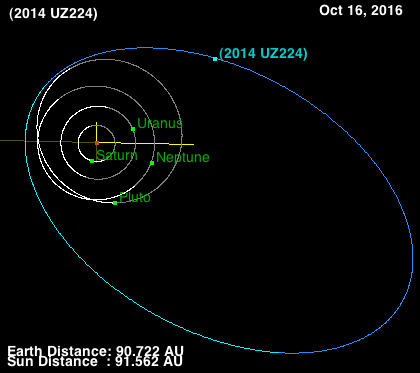2014 UZ224 on:
[Wikipedia]
[Google]
[Amazon]
is a  was discovered by a team led by David Gerdes using data collected by the large camera Dark Energy Camera (DECam). It has a diameter of ~ and reflects just 13 percent of the sunlight that hits it on its approximately 1,100 year orbit around the Sun. Since the numbering of in May 2019, may be the largest unnumbered object in the Solar System (though see 2012 VP113). The earliest known
was discovered by a team led by David Gerdes using data collected by the large camera Dark Energy Camera (DECam). It has a diameter of ~ and reflects just 13 percent of the sunlight that hits it on its approximately 1,100 year orbit around the Sun. Since the numbering of in May 2019, may be the largest unnumbered object in the Solar System (though see 2012 VP113). The earliest known
2014 UZ224 ("DeeDee") Fact Sheet
* * {{DEFAULTSORT:2014 UZ224 # Minor planet object articles (unnumbered) # 20140819
trans-Neptunian object
A trans-Neptunian object (TNO), also written transneptunian object, is any minor planet in the Solar System that orbits the Sun at a greater average distance than Neptune, which has a semi-major axis of 30.1 astronomical units (au).
Typically, ...
and possible dwarf planet orbiting in the scattered disc
The scattered disc (or scattered disk) is a distant circumstellar disc in the Solar System that is sparsely populated by icy small solar system bodies, which are a subset of the broader family of trans-Neptunian objects. The scattered-disc objec ...
of the outermost Solar System. , it is approximately from the Sun
The Sun is the star at the center of the Solar System. It is a nearly perfect ball of hot plasma, heated to incandescence by nuclear fusion reactions in its core. The Sun radiates this energy mainly as light, ultraviolet, and infrared radi ...
, and will slowly decrease in distance until it reaches its perihelion
An apsis (; ) is the farthest or nearest point in the orbit of a planetary body about its primary body. For example, the apsides of the Earth are called the aphelion and perihelion.
General description
There are two apsides in any ellip ...
of 38 AU in 2142. The discoverers have nicknamed it "DeeDee" for "Distant Dwarf".
 was discovered by a team led by David Gerdes using data collected by the large camera Dark Energy Camera (DECam). It has a diameter of ~ and reflects just 13 percent of the sunlight that hits it on its approximately 1,100 year orbit around the Sun. Since the numbering of in May 2019, may be the largest unnumbered object in the Solar System (though see 2012 VP113). The earliest known
was discovered by a team led by David Gerdes using data collected by the large camera Dark Energy Camera (DECam). It has a diameter of ~ and reflects just 13 percent of the sunlight that hits it on its approximately 1,100 year orbit around the Sun. Since the numbering of in May 2019, may be the largest unnumbered object in the Solar System (though see 2012 VP113). The earliest known precovery
In astronomy, precovery (short for pre-discovery recovery) is the process of finding the image of an object in images or photographic plates predating its discovery, typically for the purpose of calculating a more accurate orbit. This happens mos ...
observations of were taken at the Mauna Kea Observatory
The Mauna Kea Observatories (MKO) are a group of independent astronomical research facilities and large telescope observatories that are located at the summit of Mauna Kea on the Big Island of Hawaiʻi, United States. The facilities are located ...
on 15 October 2006.
See also
*List of Solar System objects most distant from the Sun
These Solar System minor planets are the furthest from the Sun . The objects have been categorized by their approximate current distance from the Sun, and not by the calculated aphelion of their orbit. The list changes over time because the obj ...
* List of Solar System objects by greatest aphelion
This is a list of Solar System objects by greatest aphelion or the greatest distance from the Sun that the orbit could take it if the Sun and object were the only objects in the universe. It is implied that the object is orbiting the Sun in a t ...
References
External links
2014 UZ224 ("DeeDee") Fact Sheet
* * {{DEFAULTSORT:2014 UZ224 # Minor planet object articles (unnumbered) # 20140819